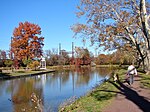The Delaware Division of the Pennsylvania Canal, more commonly called the Delaware Canal, runs for 60 miles (97 km) parallel to the right bank of the Delaware River from the entry locks near the mouth of the Lehigh River and terminal end of the Lehigh Canal at Easton south to Bristol. At Easton, which today is the home of The National Canal Museum, the Delaware Canal also connected with the Morris Canal built to carry anthracite coal to energy-starved New Jersey industries.
Later, with a crossing-lock constructed at New Hope, the New Hope 'outlet lock' (1847) connected by Cable Ferry to enter at Lambertville, NJ; where it connected to a feeder navigation/canal that began at Bull's Island opposite Lumberville; which then ran over 22 miles (35 km) south along the New Jersey bank of the Delaware River through Trenton to Bordentown, the west end of the Delaware and Raritan Canal (1834) to New York City via New Brunswick.
The Commonwealth of Pennsylvania built the Delaware canal to feed anthracite stone coal to energy-hungry Philadelphia as part of its transportation infrastructure building plan known as the Main Line of Public Works—a legislative initiative creating a collection of self-reinforcing internal improvements to commercial transportation capabilities.
The Delaware Canal, like the Lehigh Canal, was primarily meant to carry anthracite coal and other bulk goods such as gravel and limestone, cement, and lumber—from northeastern Pennsylvania to Philadelphia. In reverse flow, the two canals carried manufactured goods, iron products and (a few decades later) steel products to the northeastern cities. The Delaware and Lehigh Canals also connected from Easton by ferry services across the Delaware River to New Jersey and the Delaware and Raritan Canal, connecting industrial loads to New York City.
First opened in 1832, the Delaware Canal still has most of its original locks, aqueducts, and overflows. Although the two canals reached their peak shipping in 1855, after which coal transport down the Lehigh corridor was taken up increasingly by railroads, the canals stayed in operation until the Great Depression in the early 1930s. According to the National Park Service, it was the "longest-lived canal in the country".







